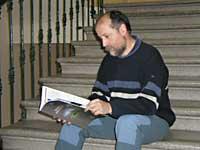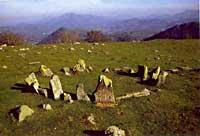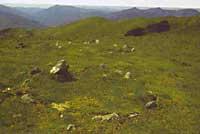Mairubaratza. Presentation of the book Pirenaicos Cromlech
2004/11/11 Galarraga Aiestaran, Ana - Elhuyar Zientzia

The book is divided into two parts. In the first, the inventory of mortuary orchards is described, where its presence in the entire Pyrenees is evident, above all the current limits. It defines the area in which the gardens of Mairu appear: it borders to the west with the river Leitzaran and to the east extend to Andorra. In the wide area are between 5 and 50 km.
The fact that the area is so limited and unique reveals the existence of a cultural union between those who made orchards of moors. Who were these human beings? Where did they live? This is the second part of the book.

At the time, people living in the walled villages of Gipuzkoa and Bizkaia are investigating Xabier Peñalver. Initially it could be thought that the inhabitants of these villages went to the mountain in summer with animals and that they made moors for those who died there. However, given that the border is so clear and that, in addition, there is no cromlech around these villages, this hypothesis has been ruled out. Probably, the inhabitants of the Gipuzkoan and Vizcaine villages buried their dead after burning them, but they did not highlight the place buried with stones. On the other hand, the sheep would not move to the Pyrenees, but to the nearby mountains, as today: Aralar, Aizkorri...
However, Peñalver believes that the people who made orchards of moro or crómlech lived in the Pyrenean valleys, in the same areas in which today are the villages. Apparently, when someone died, they burned the body and carried the ashes to the top of the mountains. These ashes were placed in the center of the purple orchard, sometimes in a hole in the ground, others inside a container...

Each of the moor gardens contains the ashes of a single death, which is also remarkable, since in other places the tombs were collective. Some crómlech appear in groups, but usually they are not very large, and most are alone.
This 271 page book explains where they are, how many they are and what specific characteristics they have. The book also consists of 176 photographs, several images and, on a map that spreads, all the sites, each with its corresponding catalog number.
In passing, Peñalver has also put a job to linguists. In the last paragraph of the book he writes: In our opinion, the abundance of crómlech to the east of the Leitzaran River, and its total absence to the west of the river, may have to do with the territory dependent on the Vascons, whose western limit of its territory coincides with that of the crómlech. This limitation, on the other hand, distinguishes two dialects of the Basque language."

Gai honi buruzko eduki gehiago
Elhuyarrek garatutako teknologia



